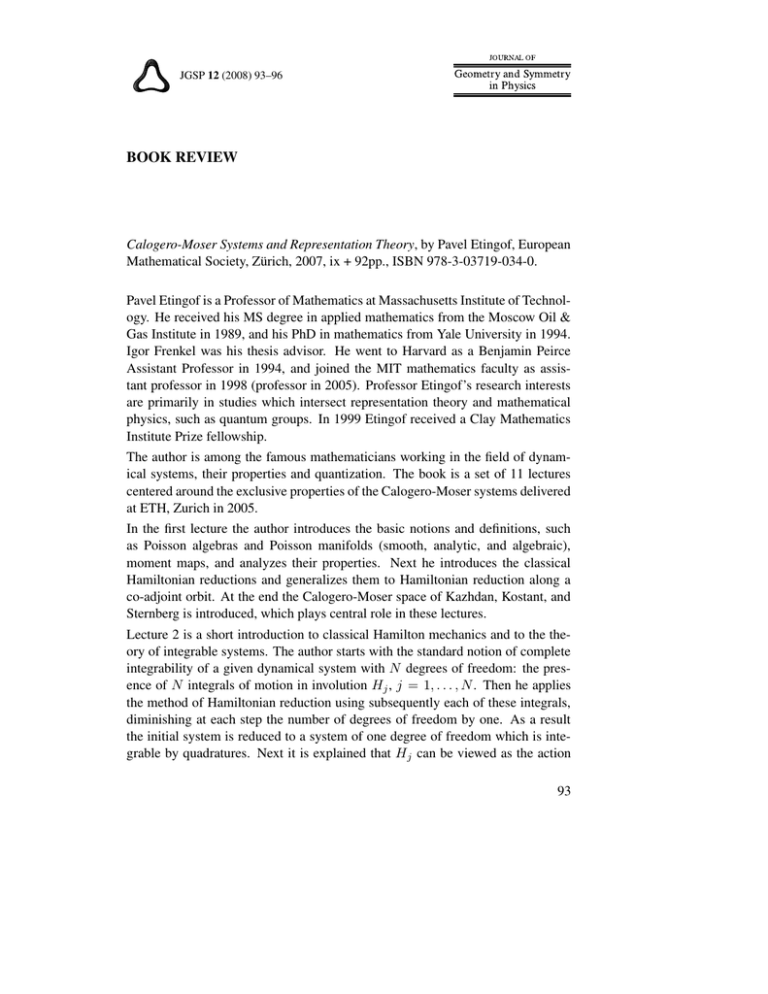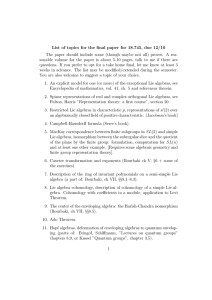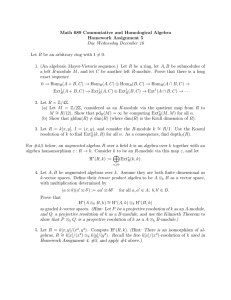BOOK REVIEW
advertisement

JGSP 12 (2008) 93–96 BOOK REVIEW Calogero-Moser Systems and Representation Theory, by Pavel Etingof, European Mathematical Society, Zürich, 2007, ix + 92pp., ISBN 978-3-03719-034-0. Pavel Etingof is a Professor of Mathematics at Massachusetts Institute of Technology. He received his MS degree in applied mathematics from the Moscow Oil & Gas Institute in 1989, and his PhD in mathematics from Yale University in 1994. Igor Frenkel was his thesis advisor. He went to Harvard as a Benjamin Peirce Assistant Professor in 1994, and joined the MIT mathematics faculty as assistant professor in 1998 (professor in 2005). Professor Etingof’s research interests are primarily in studies which intersect representation theory and mathematical physics, such as quantum groups. In 1999 Etingof received a Clay Mathematics Institute Prize fellowship. The author is among the famous mathematicians working in the field of dynamical systems, their properties and quantization. The book is a set of 11 lectures centered around the exclusive properties of the Calogero-Moser systems delivered at ETH, Zurich in 2005. In the first lecture the author introduces the basic notions and definitions, such as Poisson algebras and Poisson manifolds (smooth, analytic, and algebraic), moment maps, and analyzes their properties. Next he introduces the classical Hamiltonian reductions and generalizes them to Hamiltonian reduction along a co-adjoint orbit. At the end the Calogero-Moser space of Kazhdan, Kostant, and Sternberg is introduced, which plays central role in these lectures. Lecture 2 is a short introduction to classical Hamilton mechanics and to the theory of integrable systems. The author starts with the standard notion of complete integrability of a given dynamical system with N degrees of freedom: the presence of N integrals of motion in involution Hj , j = 1, . . . , N . Then he applies the method of Hamiltonian reduction using subsequently each of these integrals, diminishing at each step the number of degrees of freedom by one. As a result the initial system is reduced to a system of one degree of freedom which is integrable by quadratures. Next it is explained that Hj can be viewed as the action 93 94 Book Review coordinates of the system and is explained how the dual angle coordinates φ k , k = 1, . . . , N can be constructed. As a result the symplectic form of the dynamiN P dHk ∧ dφk . This construction is cal system acquires the canonical form ω = k=1 illustrated by the classical Calogero-Moser integrable system using Hamiltonian reduction along a coadjoint orbit (the Kazhdan-Kostant-Sternberg construction), and by finding its solutions. Then, by introducing coordinates on the CalogeroMoser space, he writes both the system and the solutions explicitly, thus recovering the standard results about the Calogero-Moser system. Finally, he generalizes these results to construct the trigonometric Calogero-Moser system. The next Lecture 3 is an introduction to theory of formal and algebraic deformations of associative algebras. This allows, in particular, to discuss quantummechanical versions of the notions and results of Lectures 1 and 2 in a manner parallel to the classical case. The author introduces Hochschild cohomology and discusses its role in studying deformations; he also defines universal deformations. The basics of the theory of deformations and quantization of Poisson (or symplectic) manifolds are outlined, and the Kontsevich quantization theorem is formulated. The quantum-mechanical generalization of the standard Hamiltonian systems is outlined in Lecture 4. The author defines the notions of quantum moment map and quantum Hamiltonian reduction and gives an example of computation of quantum reduction (the Levasseur-Stafford theorem), which is the quantum analog of the example of commuting variety given in Lecture 1. Next he defines the notion of quantum reduction with respect to an ideal in the enveloping algebra, which is the quantum version of reduction along a coadjoint orbit, and give an example of this reduction – the construction of the spherical subalgebra of the rational Cherednik algebra. Being a quantization of the Calogero-Moser space, this algebra is to play a central role in the subsequent lectures. In Lecture 5 the notion of a quantum integrable system is introduced. The construction of quantum integrable systems by means of quantum reduction (with respect to an ideal) is outlined. An example of this, which is central to the exposition is given – the quantum Calogero-Moser system. More general classical and quantum Calogero-Moser systems, which are associated to finite Coxeter groups are studied in Lecture 6. The systems defined in previous lectures correspond to the case of the symmetric group. In general, these integrable systems are not known (or expected) to have a simple construction via reduction; in their construction and study, Dunkl operators are an indispensible tool. The author introduces the Dunkl operators (both classical and quantum), Book Review 95 and explains how the Olshanetsky-Perelomov Hamiltonians are constructed from them. Lecture 7 is dedicated to the study of the rational Cherednik algebra, which naturally arises from Dunkl operators (namely, it is generated by Dunkl operators, coordinates, and reflections). Using the Dunkl operator representation, the PoincareBirkhoff-Witt theorem for this algebra is proved, and its spherical subalgebra and center are studied. The symplectic reflection algebras, associated to a finite group G of automorphisms of a symplectic vector space V are considered in Lecture 8. These algebras are natural generalizations of rational Cherednik algebras, although in general they are not related to any integrable system. It is shown that the PBW theorem does generalize to these algebras, but its proof does not, since Dunkl operators do not have a counterpart. Instead, the proof is based on the theory of deformations of Koszul algebras, due to Drinfeld, Braverman-Gaitsgory, Polishchuk-Positselski, and Beilinson-Ginzburg-Soergel. The author considers spherical subalgebra of the symplectic reflection algebra, and shows by deformation-theoretic arguments that it is commutative if the Planck constant is equal to zero. In Lecture 9, the deformation-theoretic interpretation of the symplectic reflection algebras is described. It is shown that they are universal deformations of semidirect products of G with the Weyl algebra of V . The center of the symplectic reflection algebra, in the case when the Planck constant equals zero is studied in Lecture 10. The spectrum of the center, which is an algebraic variety analogous to the Calogero-Moser space, is shown to be the smooth locus of this variety, i.e., it is exactly the set of points where the symplectic reflection algebra is an Azumaya algebra. The proofs require some tools from homological algebra, such as the Cohen-Macaulay property and homological dimension, which are briefly introduced. The finite dimensional representations of symplectic reflection algebras with the zero value of the Planck constant are also studied. In particular, it is shown that for G being the symmetric group S n (i.e., in the case of rational Cherednik algebras of type A), every irreducible representation has dimension n!. The irreducible representations are parametrized by the Calogero-Moser space defined in Lecture 1. A similar theorem is valid if G = Sn n Γn , where Γ is a finite subgroup of SL(2, C). The last Lecture 11 is dedicated to the representation theory of the rational Cherednik algebras with a nonzero Planck constant. By analogy with semisimple Lie algebras, the theory of category O is developed. In particular, Verma modules, irreducible highest weight modules, which are labeled by representations of G are 96 Book Review introduced and the characters of the Verma modules are computed. The main challenge is to compute the characters of irreducible modules, and to find out which of them are finite dimensional. Some of this in the case when G = S n n Γn , where Γ is a cyclic group. In particular, the characters of all finite dimensional simple modules in the case G = Sn (rational Cherednik algebra of type A) are constructed and computed. It turns out that a finite dimensional simple module exists if and only if the parameter k of the Cherednik algebra equals r/n, where r is an integer relatively prime to n. For such values of k, the representation is unique, its dimension is |r|n−1 , and it has no self-extensions. At the end of each lecture, remarks and references, designed to put the material of the lecture in a broader prospective, and link it with the existing literature are provided. However, due to the limited size and scope of these lectures, unfortunately, the author has been able to give an exhaustive list of references on Calogero-Moser systems. Such a list would have to be truly enormous. The attentive reader will find these lectures very useful. The level is however rather high. It is assumed that the reader is familiar with the differential geometry, the theory of symplectic and Poisson manifolds, the theory of dynamical systems and cohomology theory. Vladimir Gerdjikov Institute of Nuclear Research and Nuclear Energy Bulgarian Academy of Sciences Blvd. Tsarigradsko chaussée 72, Sofia 1784 BULGARIA E-mail address: gerjikov@inrne.bas.bg


